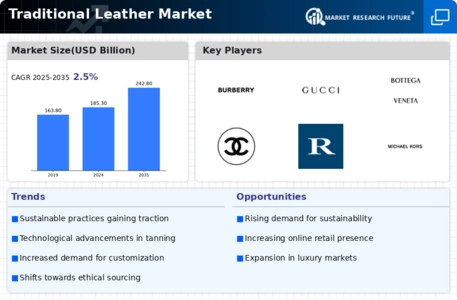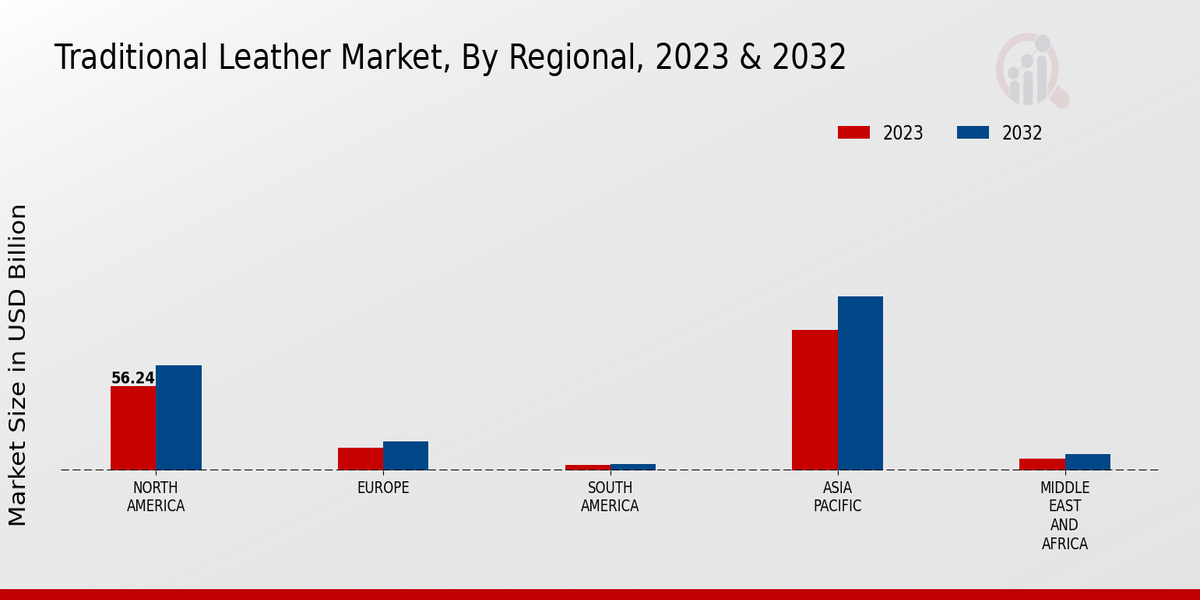Market Growth Projections
The Global Traditional Leather Market Industry is poised for substantial growth, with projections indicating a market value of 185.3 USD Billion in 2024 and an anticipated increase to 242.8 USD Billion by 2035. This growth trajectory suggests a compound annual growth rate (CAGR) of 2.48% from 2025 to 2035. Such figures reflect the industry's resilience and adaptability in response to evolving consumer preferences and market dynamics. The increasing demand for leather products across various sectors, coupled with advancements in production technologies, positions the market favorably for sustained expansion.
Growth of E-commerce Platforms
The rise of e-commerce platforms significantly impacts the Global Traditional Leather Market Industry by providing consumers with greater access to a diverse range of leather products. Online retailing allows brands to reach a global audience, overcoming geographical barriers that previously limited market reach. This trend is particularly beneficial for small and medium-sized enterprises that can now showcase their products to a wider customer base. As e-commerce continues to grow, it is likely to drive sales in the leather sector, contributing to the overall market growth and enhancing competition among brands.
Cultural Significance and Heritage
The cultural significance of leather in various regions plays a crucial role in the Global Traditional Leather Market Industry. In many cultures, leather products are associated with craftsmanship and tradition, often passed down through generations. This heritage fosters a strong consumer preference for traditional leather goods, particularly in regions where artisanal production is prevalent. For instance, countries known for their leather craftsmanship, such as Italy and India, continue to thrive in the global market. This cultural attachment not only sustains demand but also encourages the preservation of traditional techniques, further enhancing the market's resilience.
Rising Demand for Sustainable Products
The Global Traditional Leather Market Industry experiences a notable shift towards sustainability, as consumers increasingly prioritize eco-friendly products. This trend is driven by heightened awareness of environmental issues and the impact of leather production on ecosystems. Brands are responding by adopting sustainable practices, such as sourcing leather from environmentally responsible tanneries. This shift not only caters to consumer preferences but also aligns with regulatory frameworks promoting sustainable manufacturing. As a result, the market is projected to reach 185.3 USD Billion in 2024, reflecting a growing segment focused on sustainable leather solutions.
Expanding Applications of Leather Products
The versatility of leather contributes to its expanding applications across various sectors, thereby bolstering the Global Traditional Leather Market Industry. Leather is not only utilized in fashion and accessories but also finds significant use in automotive interiors, furniture, and even electronics. This diversification allows manufacturers to tap into new markets and consumer segments. For example, the automotive industry increasingly opts for premium leather upholstery, enhancing vehicle aesthetics and comfort. This broadening of applications is expected to support the market's growth trajectory, with projections indicating a rise to 242.8 USD Billion by 2035.
Technological Advancements in Leather Processing
Innovations in leather processing technologies significantly influence the Global Traditional Leather Market Industry. Advanced techniques, such as digital printing and automated tanning processes, enhance efficiency and reduce waste. These technologies not only improve product quality but also cater to the rising demand for customization in leather goods. For instance, brands are increasingly utilizing 3D printing to create unique designs, appealing to a broader consumer base. As these technologies become more accessible, they are likely to drive market growth, contributing to an anticipated CAGR of 2.48% from 2025 to 2035.

























